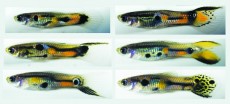Female guppies show preference for rare males in mating game
 The guppies in this photo show the variation among rare breeds of males.
The guppies in this photo show the variation among rare breeds of males.
Professor of Biology Anne Houde coauthored a study just published in the journal Nature showing sexual selection favoring unusual looking guppies over more run-of-the-mill ones.
Houde, along with Kimberly Hughes from the Department of Biology at Florida State University and Anna C. Price and F. Helen Rodd of the Department of Ecology and Evolutionary Biology at the University of Toronto, studied guppies in Trinidad and found that male guppies with rare color patterns mated more — and lived longer — than the common males. And the males’ actual appearance didn’t matter to the females, who are tan in color and do the choosing of mates.
The study, which took place over several years in natural streams in Trinidad, looked at guppy populations over several generations to see over time whether rare or common-looking male guppies were being chosen more often as mates by females.
“What we find is females are much more likely to seek out mates that have unusual coloring or markings in their tails,” Houde explained. “The ones with the more usual or ‘redundant’ markings are left behind, evolutionarily speaking.
“Over time and over several generations, what is left are guppy groups with many different types of males all with distinct features,” Houde said.
In other words, natural selection that favors rare types leads to great genetic diversity, or polymorphism. And this might even contribute to the variety we see in human faces.
In an earlier paper published in 2006 in Nature based on the same experimental manipulation in Trinidad streams, Hughes et al. showed that male guppies with rare color patterns had a survival advantage compared to those with common patterns in natural populations. During the same study, also in Trinidad, 70 percent of common males survived, while 85 percent of rare males survived.
This new study reports the results of paternity analyses of the offspring produced by the females in that earlier field experiment.
Their work was supported by grants from the National Science Foundation and the Natural Sciences and Engineering Research Council of Canada.